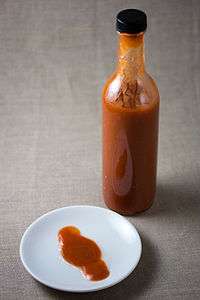Harissa
Harissa (Arabic: هريسة harīsa, from Maghrebi Arabic) is a North African hot chili pepper paste, the main ingredients of which are roasted red peppers, Baklouti pepper, serrano peppers and other hot chili peppers and spices and herbs such as garlic paste, coriander seed, saffron, rose or caraway as well as some vegetable or olive oil for preservation. It is most closely associated with Tunisia, Libya, Algeria and Morocco.[1]
History
As with the European cuisine, chili peppers were imported into Maghrebian cuisine via the Columbian Exchange,[1] presumably during the Spanish occupation of Tunisia between 1535 and 1574.[2] Recipes for harissa vary according to the household and region. Variations can include the addition of cumin, red peppers, garlic, coriander and lemon juice. In Saharan regions, harissa can have a smoky flavor. Prepared harissa is also sold in jars, cans, bottles, tubes, plastic bags and other containers.
Harissa is sometimes described as "Tunisia's main condiment",[3] even "the national condiment of Tunisia",[4] or at least as "the hallmark of Tunisia's fish and meat dishes".[5] In Tunisia, harissa is used as an ingredient in a meat (goat or lamb) or fish stew with vegetables, and as a flavoring for couscous. It is also used for lablabi, a chickpea soup usually eaten for breakfast. In Algeria, harissa is commonly added to soups, stews and couscous.[6] Harissa paste can also be used as a rub for meat[7] or eggplants.[8] In Israel, harissa is a common topping for sabich[9] and shawarma, although other hot sauces like the Yemeni zhug or the Iraqi amba are also employed.[10]
Tunisia is the biggest exporter of pre-made harissa.[11] In 2006, the Tunisian production of harissa was 22,000 tonnes, incorporating about 40,000 tonnes of peppers.[12] Tunisian harissa is often made with chilis grown around Nabeul and Gabès, which are relatively mild, scoring 40,000-50,000 on the Scoville scale.[13] Another significant producer is Algeria's Annaba Province,[14] which is also a significant consumer.[15] According to cookbook author Martha Rose Shulman, pre-made harissa tastes rather different from that which is served in Tunisian and expat restaurants.[16]
See also
- Skhug, a hot sauce in Middle Eastern cuisine, made from fresh hot peppers seasoned with coriander, garlic and various spices
- Muhammara or acuka, a hot pepper dip in Levantine cuisine
- Ajika, a dip in Caucasian cuisine, based on a boiled preparation of hot red peppers, garlic, herbs and spices
- Chermoula
- Tabil
- Gochujang, a fermented hot pepper dip made from red chilies in Korean cuisine
- List of African dishes
- List of dips
- List of sauces
References
- 1 2 Morse, Kitty; Lucy Malouf (1998). Artichoke to Za'atar: Modern Middle Eastern Food. U of California P. p. 66. ISBN 978-0-8118-1503-1.
- ↑ Gil Marks (2008). Olive Trees and Honey: A Treasury of Vegetarian Recipes from Jewish Communities Around the World. "Northwest African Chili Paste (Harissa)": Wiley. ISBN 0-544-18750-4.
- ↑ Linda Civitello (2011). Cuisine and Culture: A History of Food and People. John Wiley & Sons. p. 244. ISBN 978-1-118-09875-2.
- ↑ Jessica B. Harris (1998). The Africa Cookbook: Tastes of a Continent. Simon and Schuster. p. 137. ISBN 978-0-684-80275-6.
- ↑ Marshall Cavendish (2006). World and Its Peoples. Marshall Cavendish. p. 1282. ISBN 978-0-7614-7571-2.
- ↑ Sari Edelstein (2010). Food, Cuisine, and Cultural Competency for Culinary, Hospitality, and Nutrition Professionals. Jones & Bartlett Publishers. p. 345. ISBN 978-1-4496-5968-4.
- ↑ Fayed, Saad. "Flank Steak with Harissa". About.com. Retrieved 2009-08-02.]
- ↑ "Baby Eggplant with Harissa and Mint". Ashbury's Aubergines. Retrieved 2009-08-02.
- ↑ Jane Hughes (2013). The Adventurous Vegetarian: Around the World in 30 Meals. New Internationalist Publications, Limited. p. 182. ISBN 978-1-78026-124-9.
- ↑ Bruce Kraig; Colleen Taylor (2013). Street Food Around the World: An Encyclopedia of Food and Culture. ABC-CLIO. p. 200. ISBN 978-1-59884-955-4.
- ↑ Tunisian Harissa Export cepex.nat.tn Archived September 6, 2009, at the Wayback Machine.
- ↑ Oxford Business Group. The Report: Tunisia 2008. Oxford Business Group. p. 195. ISBN 978-1-902339-93-1.
- ↑ Donna Wheeler; Paul Clammer; Emilie Filou (2010). Tunisia. Lonely Planet. p. 53. ISBN 978-1-74179-001-6.
- ↑ Oxford Business Group (2008). The Report: Algeria 2008. Oxford Business Group. p. 230. ISBN 978-1-902339-09-2.
- ↑ Ken Albala (2011). Food Cultures of the World Encyclopedia. ABC-CLIO. p. 7. ISBN 978-0-313-37626-9.
- ↑ Martha Rose Shulman (2014). The Simple Art of Vegetarian Cooking: Templates and Lessons for Making Delicious Meatless Meals Every Day. Rodale. p. 254. ISBN 978-1-62336-130-3.
External links
- British Dictionary definitions for harissa
- North America's Harissa in a tube
- Harissa: The Catsup of Tunisia Ciaoprochef
- Tunisian Harissa Recipesource.com
- The Japanese Discover Tunisian Harissa allvoices.com
- Tunisian Harissa Recipe
- Harissa Recipe Foodista
- HARISSA OIL RECIPE
